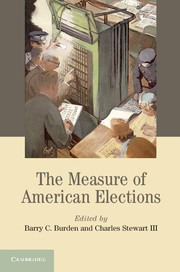Book contents
- Frontmatter
- Contents
- List of figures
- List of tables
- List of contributors
- Acknowledgments
- 1 Introduction to the Measure of American Elections
- 2 Registration and Voting: A View from the Top
- 3 Voter Registration: The Process and Quality of Lists
- 4 Provisional Ballots
- 5 Mail Ballots in the United States: Policy Choice and Administrative Challenges
- 6 Voting from Abroad: Evaluating UOCAVA Voting
- 7 Polling Place Practices and the Voting Experience
- 8 Disability and Election Policies and Practices
- 9 The Performance of Election Machines and the Decline of Residual Votes in the United States
- 10 Voter Confidence as a Metric of Election Performance
- 11 Election Data Transparency
- Appendix
- References
- Index
4 - Provisional Ballots
Published online by Cambridge University Press: 05 August 2014
- Frontmatter
- Contents
- List of figures
- List of tables
- List of contributors
- Acknowledgments
- 1 Introduction to the Measure of American Elections
- 2 Registration and Voting: A View from the Top
- 3 Voter Registration: The Process and Quality of Lists
- 4 Provisional Ballots
- 5 Mail Ballots in the United States: Policy Choice and Administrative Challenges
- 6 Voting from Abroad: Evaluating UOCAVA Voting
- 7 Polling Place Practices and the Voting Experience
- 8 Disability and Election Policies and Practices
- 9 The Performance of Election Machines and the Decline of Residual Votes in the United States
- 10 Voter Confidence as a Metric of Election Performance
- 11 Election Data Transparency
- Appendix
- References
- Index
Summary
Over a decade has passed since Congress passed the Help America Vote Act (HAVA) in 2002, largely in response to the problems experienced in Florida during the 2000 presidential election. Despite the appropriation of more than $3.5 billion, there are still persistent problems with the administration of elections in the United States. Some encompass technical problems involving computerized voting equipment, voter lists, and the software used to manage them, but many others are rooted in more traditional issues of candidates and political parties attempting to advantage themselves at the expense of their opponents. Indeed, contemporary elections provide many opportunities for those participating in election administration to manipulate the system intentionally for partisan advantage or to introduce inconsistencies across jurisdictions as a result of the discretion granted to state and local officials. This study focuses on a key area where partisan manipulation and local variation may be most prominent: provisional ballots.
Provisional ballots are important because they offer voters who otherwise would be denied the right to vote an opportunity to cast a ballot – at least in many cases. The Caltech/MIT Voting Technology Project (2001) provided one of the first arguments in favor of provisional voting and estimated that provisional ballots might have saved 1.5 million votes from being lost in 2000.
- Type
- Chapter
- Information
- The Measure of American Elections , pp. 91 - 112Publisher: Cambridge University PressPrint publication year: 2014
- 8
- Cited by

